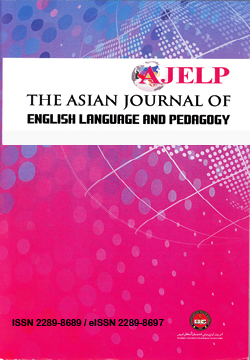Pharmacy undergraduates’ willingness to communicate (WTC) and its relationship with language learning motivation
DOI:
https://doi.org/10.37134/ajelp.vol9.1.5.2021Keywords:
Willingness to communicate (WTC), language learning motivation, Pharmacy undergraduates, second language learningAbstract
This study aimed at investigating the willingness to communicate (WTC) in English among Pharmacy undergraduates in various contexts. The study also aimed to see the relationship between WTC in English and the respondents’ language learning motivation. The data for this study was extracted from 75 Pharmacy undergraduates who have undergone their practical sessions at selected pharmacies by using a questionnaire. The study opted for a quantitative method and the questions asked were adapted from McCroskey (1992) and Lambert’s Attitude Motivation Test Battery (1987) to collect the respondents’ responses. Based on the overall score, it is clear that Pharmacy undergraduates are less willing to communicate in English despite being exposed to it since primary school. However, they are keen to communicate in English on specific situations such as when they are surrounded with familiar acquaintances. Nevertheless, the Pharmacy undergraduates have a high level of language learning motivation due to the importance of the language use for their career.
Downloads
References
Bao, D. (2014). Understanding Silence and Reticence. Ways of Participating in Second Language Acquisition. Bloomsbury Academic.
Ibrahim, Z., Hassali, M., Saleem, F., & Aljadhey, H. (2014). Perceptions and Barriers towards English Language Proficiency among Pharmacy Undergraduates at Universiti Sains Malaysia. Research in Social and Administrative Pharmacy, 10(5), e37–e38. https://doi.org/10.1016/j.sapharm.2014.07.098
Karas, M. (2016). Turn-taking and silent learning during open class discussions. Elt Journal,71. https://doi.org/10.1093/elt/ccw051
Kho-Yar, A. S., Rafik-Galea, S., & Kho, E. A. H. (2018). Willingness to Communicate in English among ESL Undergraduates in Malaysia. Journal of Cognitive Sciences and Human Development, 4(1), 28-34.
MacIntyre, P. D., & Doucette, J. (2010). Willingness to communicate and action control. System, 38(2), 161-171.
MacIntyre, P., Baker, S., Clément, R., & Donovan, L. (2003). Talking in order to learn: Willingness to communicate and intensive language programs. Canadian Modern Language Review, 59(4), 589-608.
McCroskey, J. C., & Richmond, V. P. (2013). Willingness to communicate (WTC). Measurement instrument database for the social science. Retrieved from www.midss.ie
Marcos, C. R., Werlissandra, M. S., Alessandra, R. M., Sabrina, C. S., Divaldo, P. L. J., Welligton, B. S., & Angelo, R. A. (2017). Assessment of Brazilian Pharmacy students’ perception of their level of preparedness for pharmaceutical practice. African Journal of Pharmacy and Pharmacology, 11(40), 517–525. https://doi.org/10.5897/ajpp2017.4848
Majzub, R. M., Rais, M. M., & Jusoff, K. (2010). Communication skills of practicing pharmacists and pharmacy students. Studies in Sociology of Science, 1(1), 67-72.
Milosavljević, N., & Antić, Z. (2015). Medical English Genres - Indispensable Tool for Effective Academic and Professional Communication / Žanrovi u engleskom jeziku za potrebe medicine: neophodno sredstvo za efikasnu akademsku i profesionalnu komunikaciju. Acta Facultatis Medicae Naissensis, 32(1), 77–81. https://doi.org/10.1515/afmnai-2015-0008
Musa, N. C., Lie, K. Y., & Azman, H. (2012). Exploring English language learning and teaching in Malaysia. GEMA Online® Journal of Language Studies, 12(1).
Oxford, R. (2017). Exploring Psychology in Language Learning and Teaching. Elt Journal, 71(4), 522-524.
Rogers, E. R., & King, S. R. (2012). The influence of a patient-counseling course on the communication apprehension, outcome expectations, and self-efficacy of first-year pharmacy students. American Journal of Pharmaceutical Education, 76(8).
Soo, R. S., & Goh, H. S. (2017). Pre-service English teachers’ reticent beliefs towards oral participation in EAP classrooms. The Asia-Pacific Education Researcher, 26(3-4), 155-162.
Stupans, I., March, G. J., & Elliot, E. E. (2009). Pharmacy Students’ English Language Skill Development: are we heading in the right direction? Pharmacy Education, 9.
Syakur, A., Zainuddin, H., & Hasan, M. A. (2020). Needs Analysis English For Specific Purposes (ESP) For Vocational Pharmacy Students. Budapest International Research and Critics in Linguistics and Education (BirLE) Journal, 3(2), 724–733. https://doi.org/10.33258/birle.v3i2.901
Tan, K. E., Abdullah, M. N. L. Y., Abdullah, A., Ahmad, N., Phairot, E., Jawas, U., & Liskinasih, A. (2020). Indonesian, Malaysian and Thai Secondary School Students’ Willingness to Communicate in English. Malaysian Journal of Learning and Instruction (MJLI) Vol. 17, No.1 Jan. 2020, 17(Number 1), 1–24. https://doi.org/10.32890/mjli2020.17.1.1
Wallman, A., Vaudan, C., & Sporrong, S. K. (2013). Communications training in pharmacy education, 1995-2010. American Journal of Pharmaceutical Education, 77(2).





